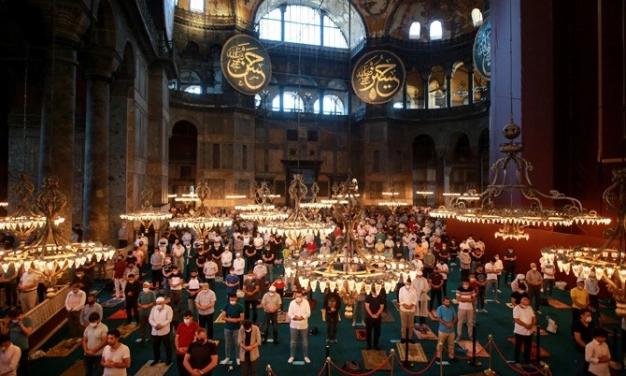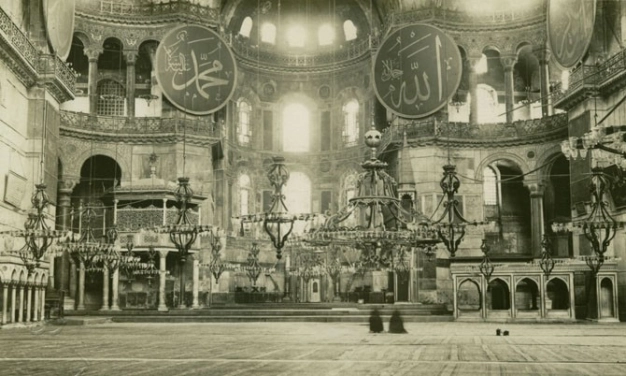- Son Dakika
- Gündem
- Ekonomi
- Finans
- Yazarlar
- Sektörel
- Dünya
- Kültür-Sanat
- Teknoloji
- FOTOĞRAF GALERİSİ
- VİDEO GALERİSİ
- e-Gazete
Gelişmelerden haberdar olmak için İstanbul Ticaret Haberleri uygulamasını indirin

 SÜMEYRA YARIŞ TOPAL
SÜMEYRA YARIŞ TOPAL
Hagia Sophia is one of the most glorious treasures creating the Istanbul brand. Finally, after 86 years, the shrine once again embraced its identity as a mosque. Hagia Sophia was qualified as a UNESCO World Heritage Site in 1985. In addition to UNESCO’s Convention Concerning the Protection of the World Cultural and Natural Heritage, the 1500-year-old historical sanctuary is being preserved by the national legislation. The Turks’ protective approach lay in the basis of Hagia Sophia’s existence of nearly one thousand and five hundred years. According to the historians of the time, the sanctuary had been a ‘wreckage’ in the years of conquest. Istanbul had been witnessing the restoration and repair works conducted on the structure since 1453.
 DARK TIMES
DARK TIMES
Hagia Sophia survived many disasters such as fires and earthquakes and frequently hosted repair and restoration works. Each disaster left a mark on this sacred venue. However, the most destructive one had occurred during the Fourth Crusade in 1204 and ruined and left sanctuary as a wreckage to the Ottoman Empire’s Istanbul. In one of his articles written in 1901, Karl Krumbacher, a German Scholer who developed the modern study of Byzantine culture, notes that many pieces from the shrine had been taken abroad. According to Krumbacher, 24 bibles, 36 censers, 300 candlesticks, 6 thousand candelabras, 300 ceremonial dresses, five crosses, two golden, three crystal and 250 silver candlesticks, and 4 torches had been removed.
 HISTORICAL OBSERVATIONS
HISTORICAL OBSERVATIONS
The ancient city witnessed four devastating fires until the conquest of Istanbul. The economic crises of those times had also blown a massive impact on the beauty of the city. Arriving in the city in 1403, the Spanish Ambassador Ruy González de Clavijo describes its state as, “A majority of the grand palaces, churches, and monasteries have been ruined…The exterior doors of Hagia Sophia are worn out.”
The Florentine priest and cartographer Cristoforo Buondelmonti arrived in Istanbul in 1422. He summarized the city’s latest state: “Merely the dome of the Hagia Sophia survived, all rest has been destroyed and ruined. The church was in a dilapidated state with several of its doors fallen from their hinge.”
A MILESTONE FOR HAGIA SOPHIA
The conquest of Istanbul had been a milestone for the Hagia Sophia after the terrible invasion it had been through. Immediately upon the conquest, Mehmed the Conquerer ordered a renovation of the building. Mehmed the Conquerer had the mosaics depicting saints and angels plastered over carefully.
 HISTORIC RESTORATION
HISTORIC RESTORATION
Hagia Sophia survived numerous earthquakes and fires, and Turks’ administration had always prioritized the restoration and repair of the shrine. The sanctuary remained closed for two years after 1847; during the period, it experienced the most significant renovation throughout its history. The covered mosaics were also opened and restored. Two hundred structural stabilization operations were conducted, and 800 workers were assigned as part of the restoration process. Upon the proclamation of the Republic, Hagia Sophia was transformed into a museum and preserved its original state with the help of the numerous restoration operations it went through.
EXHIBITED IN THE MUSEUM
After its launch as a museum, numerous historical artifacts were brought to Hagia Sophia Grand Mosque. Restored to their original state as a mosque, these artifacts in the mosque will now be exhibited at the historical building of the 2nd District Office of the Istanbul Land Registry and Cadastre in Sultanahmet. The history of this building to be used as the Hagia Sophia Museum dates back to 1881.
 PRAYER WITH THE MOSAICS
PRAYER WITH THE MOSAICS
Despite the prayers performed in Hagia Sophia, the mosaics were not covered. It is possible to prove to the Western world that the Hagia Sophia preserved its original state for centuries, even after it was converted into a mosque by the drawings of Cornelius Loos from Sweden who visited Istanbul.
BARTHOLOMEW’S STATEMENT
In the 1930s, Thomas Whittemore led a team from Byzantine Institute of America to Istanbul for running research on the mosaics of Hagia Sophia. Whittemore wrote, “There is no evidence on the destruction of these mosaics by human beings. On the contrary, hundreds of crosses across the church that remained undestroyed are the indicators of Turk’s preservation of the building.” Upon discovering the ‘Seraphim Angels’ on the walls of Hagia Sophia after long centuries in 2010, the Ecumenical Patriarch of the Eastern Orthodox Church, Bartholomew, noted, “This discovery is the proof of this shrine’s protection of many other treasures.”
AKHTAMAR CHURCH OPENS TO PRAYER AFTER 95 YEARS
Turkey’s policy on preserving the diversification in its lands had always stood out. In recent years, over one thousand and fifteen estates were returned to the non-Muslim groups. The first Assyrian School started education in 2014. Four hundred thirty-five churches and synagogues became operational again. The Sumela Monastery was opened after 90 years, and the Akhtamar Church in Van that came back to life after 95 years and Europe’s greatest synagogue, The Grand Synagogue of Edirne, was restored reopened after 46 years are among them.